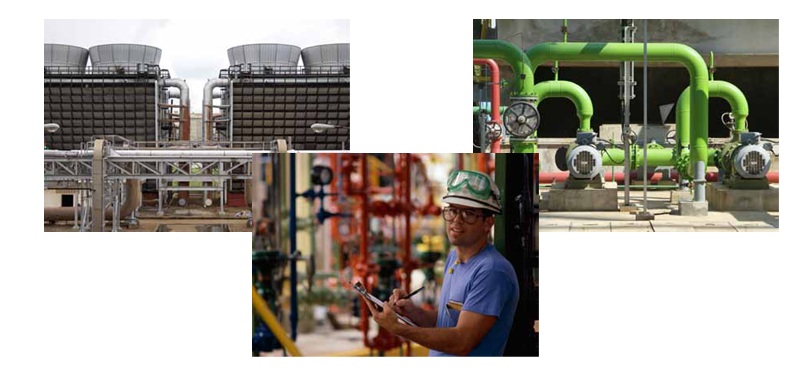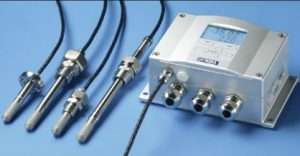Outdoor Wet-bulb Temperature – The Defining Measurement for Cooling Tower Operations

Cooling towers can be operated for peak efficiency under the following conditions: outdoor wet-bulb temperature is used as the basis for the control system set point, measurement instruments are accurate and reliable, and operators routinely check instruments for sensor drift. Shortcomings in any of these areas can result in cooling tower overuse, which leads to increased water and energy usage and reduces the functional life of fans and pumps.
Industrial-scale Evaporative Cooling
The function of the cooling tower is to remove heat from the process fluids, in this case from the condenser water used to cool the refrigerant in the chiller unit of the HVAC system. In the chiller, there is an exchange of heat from the refrigerant to the condenser water. This exchange cools the refrigerant and heats the condenser water.
The waste heat must be removed from the condenser water before it can accept more heat from the refrigerant. The heated condenser water is circulated out of the chiller to a cooling tower, where it is distributed onto complex porous surfaces and exposed to increased air flow provided by fans to maximize evaporation and remove heat from the water. The cooled condenser water is returned to the chiller to accept heat again from the refrigerant.
Water, Energy, and Equipment Costs
Water and energy use are two operational cost drivers of a cooling tower. Condenser water lost to evaporation needs to be replaced and energy is consumed to run the tower’s fans and pumps. A cooling tower with an automated control system is designed to operate at peak efficiency, minimizing these operational costs and reducing maintenance and repair costs to fan and pump equipment.
Set Point Based on Wet-bulb Temperature
Like the rest of the HVAC system, the cooling tower is operated by a control system that uses set points to govern operations. The most common set points for HVAC systems are specified upper and lower limits of temperature and humidity. Cooling tower controls are based on a single lower-limit set point, outdoor wetbulb temperature.
Evaporative cooling benefits cease when a combination of environmental variables – relative humidity, water vapor saturation pressure, and temperature – reach a point where liquid water cannot vaporize into the air. Outdoor wet-bulb temperature is the lowest temperature that can be achieved purely by evaporative cooling and is the lowest possible temperature of the process water leaving the tower. Wet-bulb temperature is always less than or equal to the dry-bulb, or ambient air, temperature.
“Cooling towers are designed to operate to a range of wet-bulb temperatures in a certain location. Tower operators need to be able to answer the question ‘What is the wet-bulb temperature?’ If they can’t answer that question, they are not using the best measurement for their operations,” says Tim Wilcox, an international energy efficiency consultant with U.S.-based WPI.
Dew Point Temperature is an Option
 Dew point is the temperature where condensation begins. This is the temperature at which air becomes fully saturated with water vapor resulting in the formation of liquid water. For use in cooling tower control systems, dew point temperature is the next best measurement to wet-bulb temperature since it measures a temperature where water is condensing (not vaporizing) and it correlates with the amount of water vapor in the air at that temperature.
Dew point is the temperature where condensation begins. This is the temperature at which air becomes fully saturated with water vapor resulting in the formation of liquid water. For use in cooling tower control systems, dew point temperature is the next best measurement to wet-bulb temperature since it measures a temperature where water is condensing (not vaporizing) and it correlates with the amount of water vapor in the air at that temperature.
Like wet-bulb temperature, dew point temperature is always less than or equal to the dry-bulb temperature.
Relative Humidity Falls Short
Relative humidity is the most commonly used humidity measurement. It is the ratio, expressed as a percentage, between the amount of water vapor present and the maximum amount that is physically possible at that temperature. The major drawback of using relative humidity is that it is heavily dependent on temperature. The capacity of air to hold water vapor is dependent on temperature. For example, if the temperature is 18°C and the relative humidity is 96%, an increase in the air temperature of only 2°C reduces the relative humidity to 85%. Due to its familiarity, relative humidity is often used in cooling tower operations, but it does not provide the temperature at which evaporative cooling effects stop. However, relative humidity and temperature from sensing devices should both be used as inputs to calculate wet-bulb temperature.
Measuring Wet-bulb Temperature
Traditionally, wet-bulb temperature was measured by a thermometer covered with wet cloth (or wet sock) and exposed to air flow. A sling psychrometer is a device with two thermometers, one thermometer measures ambient temperature (dry-bulb temperature) and the other measures wet-bulb temperature. The wet-bulb thermometer is fitted with a wet wick and then whirled around to generate air flow and evaporative cooling. These low-precision measurement instruments require manual operation and do not provide the accuracy and reliability required for industrial-scale cooling tower control systems.
Today, wet-bulb temperature is calculated based on measurements of relative humidity and temperature by accurate and reliable instruments. These calculations can be programmed into the control system to eliminate manual calculation errors.
Best Practices for Best Results
Wilcox recommends tower owners to adopt four best practices for operating the cooling tower as it was designed.
First, the mechanical engineer designing the system should specify that the control system will be preprogrammed to automatically calculate wet-bulb temperature based on direct measurements of relative humidity and temperature. The formulas can be found online and in white papers, including from Vaisala.
Second, the system designer should specify high-quality sensors that are accurate, not prone to sensor drift, and stay in calibration. “Operators do not always understand the significant financial consequence on relying on low-cost, low-quality sensors,” Wilcox says. “These inexpensive, errorprone sensors can cost hundreds of thousands of dollars in wasted energy use and equipment damage from overuse if the sensor produces inaccurate readings that indicate evaporative cooling can occur when it can’t.”
Third, during commissioning, the operator owner should confirm that the sensors and the control system program are in compliance with specification. Finally, tower operators need to perform routine maintenance on the sensor as recommended by the manufacturer for accuracy and reliability over the long run.
Source: Vaisala
